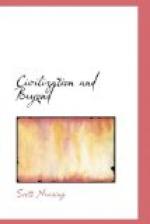Aegean civilization occupied the eastern Mediterranean for approximately two thousand years. Its nucleus was the island of Crete. Its influence extended far beyond its island base into southern Europe, western Asia and North Africa. Experiments with civilization on and near the Indian sub-continent centered around the Indonesian archipelago and the rich, semi-tropical and tropical valleys of the Ganges, the Indus, the Gadari, the Irra-waddy and the Mekong. Although they were contiguous geographically and extended over a time span of approximately two thousand years they were aggregates rather than monolithic civilizations, retaining their localisms and avoiding any strong central authority.
Beginnings of civilization have been made outside the Asian-European-African triangle centering around the Mediterranean Sea and the band of South Asia extending from Mesopotamia through India and Indonesia to China. They include the high Andes, Mexico and Central America and parts of black Africa. In no one of these cases did the beginnings reach the stability and universality that characterized the Eurasian-African civilizations.
CHAPTER TWO
ROME’S OUTSTANDING EXPERIMENT
Among the many attempts to make the institutions and practices of civilization promote human welfare, Roman civilization deserves a very high rating. First, it was located in the eastern Mediterranean area, the home-site of so many civilizations. Second, it was part and parcel of a prolonged period of attempts by Egyptians, Assyrians, Hittites, Babylonians, Mycaenians, Phoenicians and others in the area to set up successful empires and to play the lead role in building a civilization that would be more or less permanent. Third, the Romans seemed to have the hardiness, adaptability, persistence and capacity for self-discipline necessary to carry such a long term project to a successful conclusion. Among the widely varied human groups occupying the eastern Mediterranean area between 1000 B.C. and 1000 A.D., the Romans seem to have been well qualified to win the laurel crown.
Western civilization is an incomplete experiment. Its outcome remains uncertain. Its future still hangs in the insecure balance between construction and destruction, between life and extinction. It is “our” civilization in a very real sense. It was developed by our forebears. We live as part of its complex of ideas, practices, techniques, institutions. Since we are in it and of it, it is difficult for us humans to judge it objectively.
Roman civilization, on the contrary, is a completed experiment, one that came into being, developed over several centuries, attained a zenith of wealth and power, then sank gradually from sight, until it lived only as a part of history. A study of Roman civilization has two advantages. First, its life cycle has been completed. Second, it is close enough to us in history and its records are so numerous and so well preserved that we can form a fairly accurate picture of its structure and its functions. It was written up extensively by the Romans themselves, by their Greek and other contemporaries and by a host of scholars and students; since the break-up of Roman civilization as a political, economic and cultural force in world affairs.




